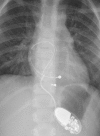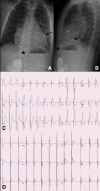Congenital and childhood atrioventricular blocks: pathophysiology and contemporary management
- PMID: 27351174
- PMCID: PMC5005411
- DOI: 10.1007/s00431-016-2748-0
Congenital and childhood atrioventricular blocks: pathophysiology and contemporary management
Abstract
Atrioventricular block is classified as congenital if diagnosed in utero, at birth, or within the first month of life. The pathophysiological process is believed to be due to immune-mediated injury of the conduction system, which occurs as a result of transplacental passage of maternal anti-SSA/Ro-SSB/La antibodies. Childhood atrioventricular block is therefore diagnosed between the first month and the 18th year of life. Genetic variants in multiple genes have been described to date in the pathogenesis of inherited progressive cardiac conduction disorders. Indications and techniques of cardiac pacing have also evolved to allow safe permanent cardiac pacing in almost all patients, including those with structural heart abnormalities.
Conclusion: Early diagnosis and appropriate management are critical in many cases in order to prevent sudden death, and this review critically assesses our current understanding of the pathogenetic mechanisms, clinical course, and optimal management of congenital and childhood AV block.
What is known: • Prevalence of congenital heart block of 1 per 15,000 to 20,000 live births. AV block is defined as congenital if diagnosed in utero, at birth, or within the first month of life, whereas childhood AV block is diagnosed between the first month and the 18th year of life. As a result of several different etiologies, congenital and childhood atrioventricular block may occur in an entirely structurally normal heart or in association with concomitant congenital heart disease. Cardiac pacing is indicated in symptomatic patients and has several prophylactic indications in asymptomatic patients to prevent sudden death. • Autoimmune, congenital AV block is associated with a high neonatal mortality rate and development of dilated cardiomyopathy in 5 to 30 % cases. What is New: • Several genes including SCN5A have been implicated in autosomal dominant forms of familial progressive cardiac conduction disorders. • Leadless pacemaker technology and gene therapy for biological pacing are promising research fields. In utero percutaneous pacing appears to be at high risk and needs further development before it can be adopted into routine clinical practice. Cardiac resynchronization therapy is of proven value in case of pacing-induced cardiomyopathy.
Keywords: Congenital heart disease; Heart block; Outcomes; Pacemaker; Pathophysiology.
Conflict of interest statement
Compliance with ethical standards Financial disclosure None of the authors has any financial relationships relevant to this article to disclose. Conflict of interest The authors declare that they have no conflict of interest. Funding None. Ethical approval This article does not contain any studies with human participants or animals performed by any of the authors.
Figures






References
Publication types
MeSH terms
LinkOut - more resources
Full Text Sources
Other Literature Sources
Research Materials
Miscellaneous

